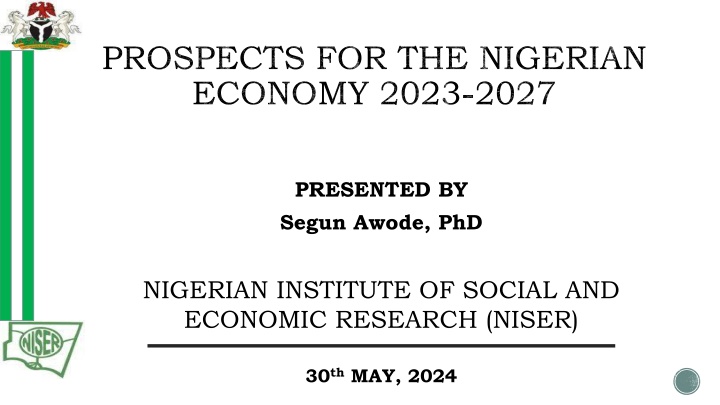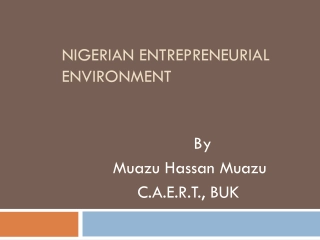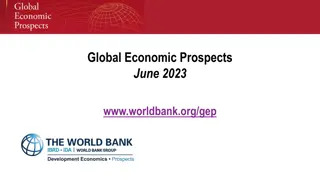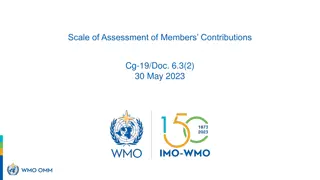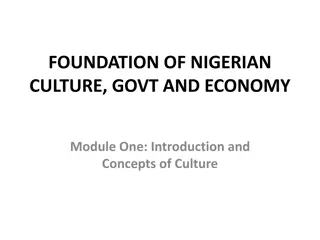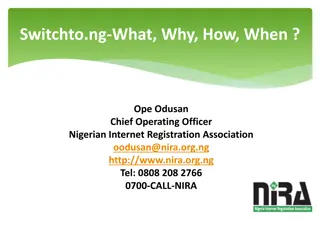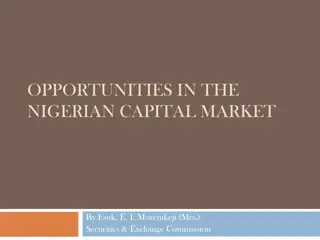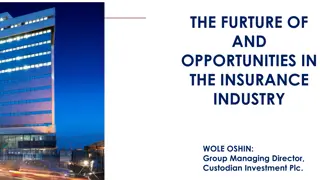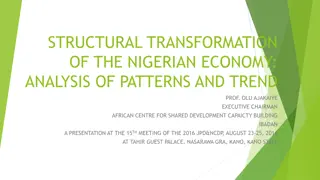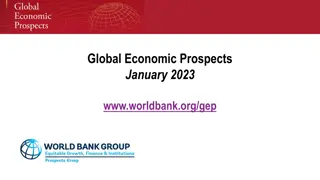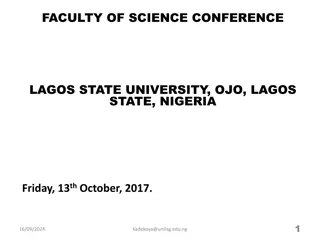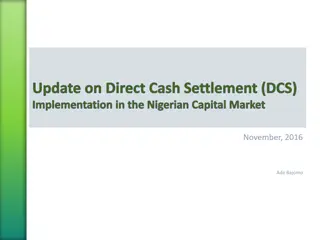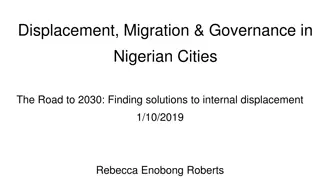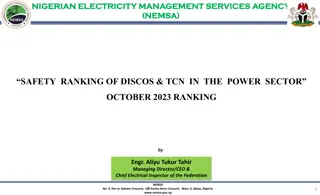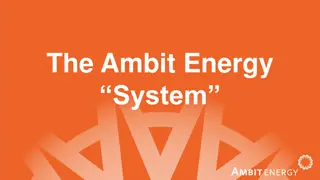Prospects for the Nigerian Economy 2023-2027: Insights and Analysis
Nigeria's economic journey from 1999 to the present, highlighting key administrations, policy shifts, and economic reforms. The period saw the establishment of democratic governance, economic diversification efforts, infrastructural investments, and bold reforms such as fuel subsidy and exchange rate policies. Challenges like corruption, security issues, and controversial policies have shaped the economic landscape, impacting factors like inflation, GDP growth, and the cost of living.
Download Presentation

Please find below an Image/Link to download the presentation.
The content on the website is provided AS IS for your information and personal use only. It may not be sold, licensed, or shared on other websites without obtaining consent from the author.If you encounter any issues during the download, it is possible that the publisher has removed the file from their server.
You are allowed to download the files provided on this website for personal or commercial use, subject to the condition that they are used lawfully. All files are the property of their respective owners.
The content on the website is provided AS IS for your information and personal use only. It may not be sold, licensed, or shared on other websites without obtaining consent from the author.
E N D
Presentation Transcript
See full size image PROSPECTS FOR THE NIGERIAN ECONOMY 2023-2027 PRESENTED BY Segun Awode, PhD NIGERIAN INSTITUTE OF SOCIAL AND ECONOMIC RESEARCH (NISER) See full size image 30th MAY, 2024
See full size image Background Background (1/3) (1/3) Nigeria s democratic journey since 1999 has seen various administrations with distinct economic policies. Each administration has faced unique challenges and prioritized different areas based on the prevailing economic and political situation. Varying degrees of success in economic management. See full size image 2
Background Background (2/3) (2/3) See full size image 1999 - 2007 Re-establishment of civilian rule after many years of military dictatorships Establishment of stable foundation for democratic governance Economic reforms NEEDS, Privatization, Debt Relief etc. 2007 - 2015 Continued economic reforms VISION 20:2020; Transformation Agenda Power Sector Reform Roadmap. Privatized power generation and distribution Agricultural Transformation Agenda (ATA) See full size image 3
Background Background (3/3) (3/3) See full size image 2015 - 2023 Anti-Corruption EFCC reinforcement. Security Boko Haram, Farmer-Herder conflicts Economic reforms Infrastructural Investment, Economic Diversification, ERGP Social Investment Programs 2023 - Present Renewed Hope Agenda Bold economic reforms Fuel subsidy policy, Exchange rate Unification Policy Necessary, but controversial due to immediate harsh effects Sense of unease and disturbing See full size image 4
See full size image MACROECONOMIC CONTEXT Exchange Rate GDP Growth Rate (%) 4 1800 3.54 3.52 3.46 1600 3.5 3.11 2.98 1400 3 2.54 2.51 1200 2.31 2.25 2.5 1000 2 800 1.5 600 1 400 0.5 200 0 0 Naira/USD Exchange Rate (Official) Naira/USD Exchange Rate (Parallel) Inflation Rate 45 40 35 30 25 20 15 See full size image 10 5 0 Jan-23 Feb-23 Mar-23 Apr-23 May-23 Jun-23 Jul-23 Aug-23 Sep-23 Oct-23 Nov-23 Dec-23 Jan-24 Feb-24 Mar-24 Apr-24 5 Headline Inflation (%) Food Inflation (%)
See full size image ESCALATED COST OF LIVING 100000 95,000 90000 80,000 80000 70000 60000 50,000 50000 15,637.74 718.00 35,000 40000 30,000 701.24 28,000 9,537.89 30000 547.00 238.11 8,726.30 20000 982 447.00 503 10000 173.08 0 PMS (per Litre) LPG (12.5kg) Rice (50kg) Garri (50kg) Beans (50kg) Cost of Healthy Diet CPI See full size image May-22 May-23 Apr-24 Where will the ship of state berth in 2027? 6
See full size image STUDY OBJECTIVE Explore the potential outcomes of Renewed Hope Agenda (RHA) economic reforms over the short and medium terms, focusing on where Nigeria might find itself by 2027. 02 See full size image 7
See full size image SOURCES OF INFORMATION Three Categories 1. Continuum (Inherited) MTNDP 2021 2025 MTEF 2023 2025 2023 Budget Removal of Petroleum Subsidy New Minimum Wage See full size image 8
See full size image SOURCES OF INFORMATION 2. Feeders (RHA) APC Manifesto Supplementary Budget 2023 Exchange Rate Unification 2024 Budget & Interventions Cash Transfer to 15 million families ( 25k each) Presidential Conditional Grant Scheme ( 200 Billion) 35k wage award to workers 25/35 % salary increase from January 2024 Presidential Infrastructure Development Fund ( 20 Trillion) See full size image 9
See full size image SOURCES OF INFORMATION 3. Other Policy Initiatives Recapitalization of Banks Reform of the FX parallel market (BDCs) Review of Electricity Tariff CNG Mass Transit Student Loan Scheme Consumer Credit Scheme See full size image 10
See full size image TOOLS OF ANALYSIS Macro-Economic Models Econometric Input-Output (I-O) Reflecting the workings of the Nigerian economy Econometric 9 blocks, 253 Equations, 332 variables (80 exogenous, 252 endogenous) Input-Output Analysis 46x46 I-O Table See full size image 11
See full size image PERFORMANCE CRITERIA Growth Total GDP Agric GDP Manufacturing GDP Services GDP Distributive Trade, Building & Construction, Mining & Quarrying. Employment Generation Job Creation & Unemployment Rate Fiscal Policy Performance Fiscal Deficit/GDP, Total Debt/GDP, Debt Service/GDP, Debt Service/Revenue ratios. Inflation See full size image Headline & Food Inflation 12
See full size image DATA SOURCES Secondary Data NISER Social & Economic Watch (N-SEW) National Bureau of Statistics (NBS) CBN Statistical Bulletins World Bank International Monetary Fund (IMF) See full size image 13
See full size image Baseline Performance: Where are we now? See full size image
See full size image MTNDP 2021 - 2025: TARGET VS ACTUAL GDP Growth (%) 5.6 6 4.6 5 3.7 4 3.2 3.11 2.98 2.74 3 1.9 2 0.51 1 0 Target Actual Target Actual Target Actual Target Actual (2024 Q1) Target Actual 2021 2022 2023 2024 2025 GDP growth consistently fell short of targets Highlights challenges in achieving economic expansion See full size image 15 15
See full size image MTNDP 2021 - 2025: TARGET VS ACTUAL Sectoral Growth Rates (%) 13.9 15 10 7.41 6.83 6.74 6.66 5.94 5.62 4.32 4.18 4.1 5 3.87 3.81 3.07 2.25 2.46 2.19 2.47 1.13 1.88 2.12 2.28 0.94 0.72 0.18 0 -0.39 Target Actual Target Actual Target Actual Target Actual (2024 Q1) Target Actual -3.05 -5 -4.62 2021 2022 2023 2024 2025 -10 Agric GDP (%) Industry GDP (%) Services GDP (%) Agricultural sector met its target in 2021, significantly underperformed afterwards. See full size image Industrial sector underperformed, suggesting inherent structural issues. Services sector exceeded targets, with strengths in ICT, finance and trade. 16 16
See full size image MTNDP 2021 - 2025: TARGET VS ACTUAL Inflationary Trend 45 40.53 40 33.69 35 27.76 30 24.52 25 20.83 20.5 19.3 18.6 18.77 17.4 18.3 18.6 20 16.98 17.4 15.4 14.9 13.7 15 11.8 10 5 0 Target Actual Target Actual Target Actual Target Actual (2024 Q1) Target Actual 2021 2022 2023 2024 2025 Headline Inflation (%) Food Inflation (%) Headline inflation consistently exceeded targets, sharply increasing in 2023 and 2024 Q1. See full size image Food inflation significantly higher than targets. Drastic increases. Highlights issues in food production, due to Agric underperformance, Naira depreciation, increased import costs, supply chain disruptions, and other supply-side constraints. 17 17
See full size image Prospects for the Nigerian Economy 2023-2027 See full size image
See full size image GDP GROWTH Total GDP Growth Rate IMF World Bank Projections YEAR NISER Projection Projections 4.00 3.50 3.00 - - 2023 2.60 2.50 2.00 2024 3.47 3.30 3.30 1.50 1.00 2025 3.65 3.10 3.70 0.50 2026 3.40 3.10 - 0.00 2023 2024 2025 2026 2027 - NISER IMF PROJECTION WORLD BANK PROJECTIONS 2027 3.42 3.10 3%+ from 2024. Steady, moderate economic growth Economic Optimism. Positive but gradual impacts of reform Similar projections from Multilateral Organizations. Shared optimism. See full size image Worrisome. Only slightly higher than 2.4% Population Growth Rate Need to Generate Higher Growth. But how?? 19 19
See full size image AGRIC GDP GROWTH YEAR NISER Agric GDP Growth Rate Growth Rate Projection 0.60 0.50 0.40 2023 0.24 0.30 2024 0.49 0.20 2025 0.51 0.10 0.00 2026 0.52 2023 2024 2025 2026 2027 Agric GDP Growth Rate 2027 0.55 Slow growth in Agric Sector Share of Agric in GDP is about 25% in 2023. Highlights importance of the sector. Slow growth highlights structural challenges that needs to be addressed for more robust growth. Insecurity, low productivity, post-harvest losses, too much focus on upstream etc. See full size image 20 20
See full size image MANUFACTURING GDP GROWTH Manufacturing GDP Growth Rate YEAR NISER 10.00 Growth Rate Projection 9.00 8.00 7.00 2023 1.95 6.00 5.00 2024 8.24 4.00 3.00 2025 8.91 2.00 1.00 2026 7.93 0.00 2023 2024 2025 2026 2027 2027 5.85 Manufacturing GDP Growt Rate Strong growth in Manufacturing Sector Will boost the sector s contribution to GDP Need for improved business environment, address multiple taxation, incentives for investment, and enhancements in infrastructure. Possibility of increased domestic and foreign investment. See full size image 21 21
See full size image SERVICES GDP GROWTH YEAR NISER Services GDP Growth rate Growth Rate Projection 10.00 9.00 8.00 7.00 2023 6.51 6.00 5.00 2024 8.32 4.00 3.00 2025 8.77 2.00 1.00 2026 8.14 0.00 2023 2024 2025 2026 2027 2027 8.27 Strong growth trajectory in Service Sector. Growth Pole Sector Overall positive outlook for the sector. See full size image 22 22
See full size image DISTRIBUTIVE TRADE GDP GROWTH YEAR NISER Distributive Trade GDP Growth Rate Growth Rate Projection 25.00 20.00 2023 11.87 15.00 2024 20.13 10.00 2025 17.16 5.00 - 2026 14.86 2023 2024 2025 2026 2027 Distributive Trade GDP 2027 13.80 Significant surge in growth in 2024. indicating early impact of reforms and interventions (Presidential Grants). Possibly driven by increased consumer spending, market expansion. Overall positive outlook for the sector. Potential for economic expansion. Further support for SMEs See full size image 23 23
See full size image BUILDING & CONSTRUCTION GDP GROWTH YEAR NISER Building & Construction GDP Growth Rate Growth Rate Projection 40.00 35.00 30.00 25.00 2023 33.45 20.00 15.00 2024 22.20 10.00 2025 17.84 5.00 2026 14.39 0.00 2023 2024 2025 2026 2027 2027 12.82 Building & Construction GDP Growth Rate Strong growth. Potential early impacts in 2024. indicating early impact of reforms and interventions. Possibly driven by increased infrastructural investment and construction activity (PIDF). Housing schemes. Real-estate investments (private-sector-led) Need for support to maintain momentum. See full size image 24 24
See full size image MINING & QUARRYING GDP GROWTH YEAR NISER Mining & Quarrying GDP Growth Rate Growth Rate Projection 14.00 12.00 10.00 2023 9.75 8.00 2024 12.11 6.00 4.00 2025 12.27 2.00 2026 10.98 0.00 2023 2024 2025 2026 2027 2027 10.82 MINING & QUARRYING GDP Consistent growth. Potential positive impacts of reforms. Another Growth Pole Sector Solid Minerals could be the new oil . See full size image 25 25
See full size image HOW TO GENERATE HIGHER GROWTH Growth Drivers High Output Multiplier Output Multiplier 8 6.8 7 5.52 6 5.1 5 4 3.04 2.83 3 1.75 1.57 1.31 2 1 0 Rail Transport & Pipelines Oil Refining Construction Manufacturing Distributive Trade Utilities (Power Supply, Water Supply Sewage Management) ICT Agriculture (Crop, Livestock, Fisheries, Forestry) (Telecommunication) See full size image 26 26
See full size image EMPLOYMENT GENERATION YEAR EMPLOYMENT GENERATION (NISER Projection) RATE OF EMPLOYMENT GENERATION UNEMPLOY-MENT (NISER Projection) 7.00 6.00 5.00 2023 1.51 5.47 4.00 2024 3.62 5.32 3.00 2025 4.53 5.12 2.00 1.00 2026 5.69 4.87 0.00 2027 6.24 4.60 2023 2024 2025 2026 2027 EMPLOYMENT GENERATION RATE OF UNEMPLOYMENT 21.58 Total Job Creation 2023-2027 is 21.58 million jobs Minimum Wage 70k 2.03 million more jobs compared to Minimum Wage 100k (19.55 million). Declining Rate of Unemployment. See full size image 27 27
See full size image FISCAL POLICY PERFORMANCE 1/4 Fed. Gov. Fiscal Deficit/GDP Ratio (%) Fed, Govt. Fiscal Deficit/GDP Ratio (%) YEAR NISER Projection IMF World Bank Projection Projection 9.00 8.00 7.00 6.00 2023 4.79 - - 5.00 4.00 2024 2.68 4.30 4.10 3.00 2.00 2025 2.72 4.50 3.70 1.00 2026 2.71 4.70 - 0.00 2023 2024 2025 2026 2027 NISER IMF Projection World Bank Projection 2027 2.16 7.70 - See full size image Within the 3% generally acceptable limit 28 28
See full size image FISCAL POLICY PERFORMANCE 2/4 Total Debt Stock/GDP Ratio (%) YEAR NISER Projection IMF PROJECTIONS Total Debt Stock/ GDP (%) 50.00 45.00 40.00 2023 37.94 39.8 35.00 30.00 2024 43.09 46.6 25.00 20.00 2025 42.24 46.8 15.00 10.00 2026 38.91 - 5.00 0.00 2027 39.23 - 2023 2024 2025 2026 2027 Internationally acceptable limit NISER IMF PROJECTIONS 77.0% for Debt/GDP ratio 40% recommended by IMF for Nigeria See full size image IMF projections for Nigeria 46.6 for 2024 46.8 for 2025 29 29
See full size image FISCAL POLICY PERFORMANCE 3/4 Total Debt Service/GDP Ratio (%) YEAR NISER Projection Total Debt Service/GDP Ratio (%) 2.50 2.00 2023 2.26 1.50 2024 1.96 1.00 2025 1.84 0.50 2026 1.66 0.00 2023 2024 2025 2026 2027 2027 1.53 Total Debt Service/GDP Ratio See full size image Considerably small and well within Internationally acceptable limit of 40% 30 30
See full size image FISCAL POLICY PERFORMANCE 4/4 Debt Service/Revenue Ratio (%) World Bank Projection YEAR NISER Projection IMF Projection Debt Service/Revenue Ratio (%) 120.00 100.00 2023 72.39 73.5 - 80.00 2024 112.10 - 61 60.00 40.00 2025 94.45 - 51 20.00 2026 89.58 - - 0.00 2023 2024 2025 2026 2027 2027 80.78 - - NISER IMF PROJETION WORLD BANK PROJECTION Relatively high Pressure to generate more revenue Pressure to borrow to service loans Progress in Revenue Collection See full size image 2023: collected 13 trillion VS Targeted 9.74 trillion Feb. 2024: collected 835.70 billion VS Feb. 2023: collected 154.25 billion 31 31 Improved Fiscal Profile
See full size image INFLATION YEAR NISER Projection (Food Inflation) NISER Projection (Headline Inflation) IMF Proj. (Headline) World Bank Proj. (Headline) Relatively High Headline and Food inflation. Rapid decline from 2025 Decelerating Trend similar for World Bank and IMF, but more optimism. 2023 2024 2025 2026 2027 33.94 37.93 16.42 10.31 6.60 32.05 25.90 13.48 7.81 5.15 24.66 25.20 14.80 14.50 14.00 - 21.70 19.60 - - FOOD & HEADLINE INFLATION 40.00 35.00 Inflationary Spiral Insecurity Agricultural Output Poor storage Post harvest losses Naira Depreciation Imported Inflation 30.00 25.00 20.00 15.00 10.00 See full size image 5.00 0.00 2023 2024 2025 2026 2027 32 32 Food Inflation (NISER) Headline Inflation (NISER) IMF Proj. (Headline) World Bank Proj.(Headline)
See full size image Hypothetical Minimum Wage 70K VS 100K Hypothetical Minimum Wage of 100k Hypothetical Minimum Wage of 70k Employment Generated (millions) DTEM_0 1.04 3.12 4.00 5.58 5.81 19.55 Rate of Food Inflation Headline Inflation Employment Generated (millions) DTEM_0 1.51 3.62 4.53 5.69 6.24 21.58 Rate of Food Inflation Headline Inflation Unemployment (NEW METHOD) RUNPM_0 5.93 5.80 5.62 5.37 5.11 Unemployment (NEW METHOD) RUNPM_0 5.47 5.32 5.12 4.87 4.60 CFD_0 33.9366 37.9249 16.4138 10.3045 6.5994 INF_0 32.0445 25.8956 13.4785 7.8040 5.1464 CFD_0 33.9398 37.9336 16.4178 10.3064 6.5997 INF_0 32.0455 25.9012 13.4812 7.8054 5.1467 Increased Job Creation for both. 100k Minimum Wage not likely to trigger higher inflation. Compensating for crash in purchasing power. Increased Productivity Expectations See full size image 33 33
See full size image CONCLUSION Stable and moderate growth. Expectedly higher than population growth rate. Services Sector is a Growth Pole Sector. Considerable Employment generation. Rate of unemployment will be trending downward Improved fiscal policy performance Inflationary spiral will be curtailed. See full size image Prospects for the economy inspires optimism and hope. 34
See full size image RECOMMENDATIONS Agricultural Sector Security Increase in land cultivated No less than 5% annually Irrigation System. Reduce reliance on rain-fed agriculture Youth friendly Agriculture Green House, Smart Agriculture, Precision planting. Increased productivity 6:1 South Africa Agric productivity See full size image Reduce post-harvest losses Farm-gate food processing 35
See full size image RECOMMENDATIONS Industry Retooling and Modernization of Manufacturing Sector Industrial Master Plan Industry 4.0 technologies to enhance productivity and competitiveness Workforce upskilling for modern manufacturing processes Continued infrastructural development power, transport Policy stability to attract and retain investments See full size image 36
See full size image RECOMMENDATIONS Services Sector Conducive Business Environment Multiple Taxation Bureaucratic process in business registration and licensing Ease of Doing Business Infrastructural Development Increased investment in transport networks and power See full size image Blue economy 37
See full size image RECOMMENDATIONS Fiscal Performance Improved fiscal discipline Transparency and accountability in government finances Reduce wastages and block leakages for improved revenue and expenditure performance Improved governance quality See full size image 38
See full size image THANK YOU FOR LISTENING See full size image 39
